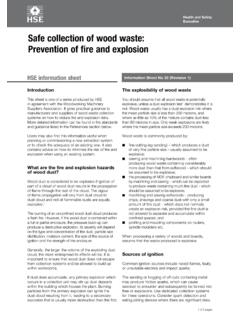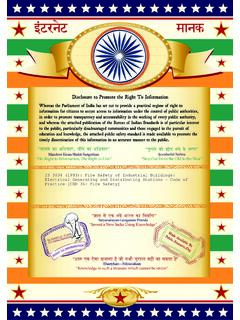Transcription of Mobile Homes Act 2013 - GOV.UK
1 Mobile Homes Act 2013. A Best Practice Guide for Local Authorities on Enforcement of the New Site Licensing Regime March 2015. Department for Communities and Local Government Crown copyright, 2015. Copyright in the typographical arrangement rests with the Crown. You may re-use this information (not including logos) free of charge in any format or medium, under the terms of the Open Government Licence. To view this licence, government-licence/version/3/ or write to the Information Policy Team, The National Archives, Kew, London TW9 4DU, or email: This document/publication is also available on our website at If you have any enquiries regarding this document/publication, complete the form at or write to us at: Department for Communities and Local Government Fry Building 2 Marsham Street London SW1P 4DF. Telephone: 030 3444 0000. For all our latest news and updates follow us on Twitter: March 2015. ISBN: 978-1-4098-4510-2.
2 2. Contents Section 1: Background Page 3. Section 2: Relevant Protected Sites Page 4. Section 3: Enforcement Policy Page 7. Section 4: Licence Conditions Page 9. Section 5: Achieving Compliance Page 16. Section 6: Roles and Responsibilities Page 23. Appendix 1: Definition of Relevant Protected Sites Page 27. Appendix 2: Definition of a caravan Page 33. Appendix 3: Example compliance notice Page 34. Appendix 4: Example proposed emergency action notice Page 42. Appendix 5: Example emergency action notice (9E)(8) Page 48. Appendix 6: Useful sources for information Page 56. 3. Section 1: Background Approximately 85,000 households live on about 2000 Mobile home sites in England. Many of these sites are well managed and run. Unfortunately there are some rogue site operators, who do not run their sites well and allow conditions to deteriorate, affecting the amenity of the site, and the health and safety of residents.
3 Local authorities are responsible for safeguarding the interests of home owners and the public at large through the licensing regime under the Caravan Sites and Control of Development Act 1960. A review by Parliament's Communities and Local Government Select Committee in early 2012 found it was outdated and did not provide local authorities with the tools or the resources to ensure effective management and maintenance of sites. The Mobile Homes Act 2013 introduced a new site licensing regime for relevant protected sites (that is park home sites and mixed sites of both residential park Homes and holiday Homes ) which came into force on 1st April 2014. The new site licensing regime gives local authorities more effective control of conditions on relevant protected sites. In appropriate cases, it provides local authorities with the tools required to take enforcement action including the power to serve compliance notices in relation to breaches of site licence conditions, emergency action powers, and the ability to carry out works in default and recover expenses.
4 Ahead of the introduction of the licensing reforms the Department of Communities and Local Government (DCLG) set up a working group of local authority practitioners, industry trade bodies and national residents' organisations to provide best practice guidance to local authorities on how to use the new licensing regime and powers to best effect. Most local authorities will already have enforcement protocols or policies in place and this guidance may be used to review and/or amend these. Additional guidance on fees setting and enforcement can be downloaded from # Mobile - Homes -act-2013. This guidance is not definitive and local authorities should seek their own legal advice if they have any doubt as to its application to cases they are dealing with. 4. Section 2: Relevant Protected Sites The new licensing regime introduced by amendments to the Caravan Sites and Control of Development Act 1960 by the Mobile Homes Act 2013 only relates to relevant protected sites.
5 These are defined by Section 5A (5) of the amended act as follows: (5) In this Part relevant protected site means land in respect of which a site licence is required under this part, other than land in respect of which the relevant planning permission under Part 3 of the Town and Country Planning Act 1990 or the site licence is, subject to subsection( 6). (a) expressed to be granted for holiday use only, or (b) otherwise so expressed or subject to such conditions that there are times of the year when no caravans may be stationed on the land for human habitation (6) For the purpose of determining whether land is a relevant protected site, any provision of the relevant planning permission or site licence which permits the stationing of a caravan on the land for human habitation all year is to be ignored if the caravan is to be occupied by: (a) the occupier (b) a person employed by the occupier but who does not occupy the caravan under an agreement to which the Mobile Homes Act 1983 applies (see section 1 (1) of that Act.)
6 Any licensable caravan site will be a relevant protected site unless it is specifically exempted from being so. A site is exempted if it has planning permission or a site licence for exclusive holiday use or there are restrictions preventing it from being used on a permanent residential basis. Holiday sites will still be subject to the licensing provisions of the Caravan Sites and Control of Development Act 1960 that existed before the Mobile Homes Act 2013. amendments, as the object of the new licensing provisions is to provide better protection of sites in residential use. This guidance relates specifically to these relevant protected sites. An exemption to the above rule is that if a holiday site has permission for residential use too, and that use is only by the owner of the site (including family members) or employees working on the site their permanent occupation does not make the site a relevant protected site.
7 The caveat to this is that if the employee occupies the home under an agreement to which the Mobile Homes Act 1983. applies, the site will be a relevant protected site. A site's exemption will depend on what use the planning permission permits; or if the permission is silent it will depend on what the site licence permits; and if there is a conflict between the planning permission and site licence as to the site's use it is the use permitted under the planning permission that applies. 5. Where both planning permission and site licence are silent about permitted use of a site the presumption would generally be that it is a relevant protected site. In such circumstances the actual use of the site may have a bearing. For further details on the definition of relevant protected sites, see the DCLG. Guidance Definition of Relevant Protected Sites at Appendix 1 which includes examples of different types of sites and tenures of occupation to illustrate the applicability of the new regime.
8 6. Section 3: Enforcement Policy Government does not envisage that local authorities should, from the 1st April 2014, rush to serve compliance notices on site operators for breaches of site licence conditions where there is not a significant risk of harm, particularly in the circumstances where the breach has existed for many years. It is expected that local authorities' actions and demands should be reasonable and proportionate. In every case where enforcement action is proposed, the interests of home owners, as well as the site operator, should be considered. Also in the case where a breach of the site licence condition is only impacting on an individual home owner, consideration should be given to the consequential impacts on other home owners. This may mean drawing a line under existing site licence condition breaches, where there is no risk of significant harm to persons or property, to enable all to move forward in a constructive and positive way.
9 It is intended that local authorities should focus their enforcement on poorly managed, badly run sites; such risk based enforcement will serve to deliver a fair and level playing field for businesses operating in the industry. Local authorities should ensure efficient and effective approaches to regulatory inspection and enforcement are provided in line with their enforcement policies and regulatory improvements should be achieved without imposing unnecessary burdens, (including in relation to timescales, costs, resources and future liability). onto the site operator. This is in accord with the Regulators' Code, which implements the Hampton Principles. In carrying out enforcement, local authorities should also be mindful of human rights and ensure any action is legitimate, appropriate and proportionate. The Regulator's Code and further resources are available at: Local authorities should always look to work with site operators in a fair, consistent and transparent way as underlined in the principles of the Regulator's Code.
10 Where possible, an informal approach to enforcement should be taken in the first instance, while recognising that this may not always be appropriate, for example where there is a significant risk to health or damage to property or where there may be evidence of previous non-compliance (and bearing in mind above where long-standing breaches may not present any risk of harm). Enforcement action must be based on the appropriate legislation. For example breaches of: Planning conditions - relevant planning legislation Site licence conditions - Caravan Sites and Control of Development Act 1960. fire safety measures Regulatory Reform ( fire Safety) Order 2005 (where this applies). Local authorities cannot enforce (or impose) site licence conditions in respect of the fabric of the Mobile home itself. A Mobile home is the property of the home owner and completely outside the control of the site operator and the scope of site licence conditions.

















